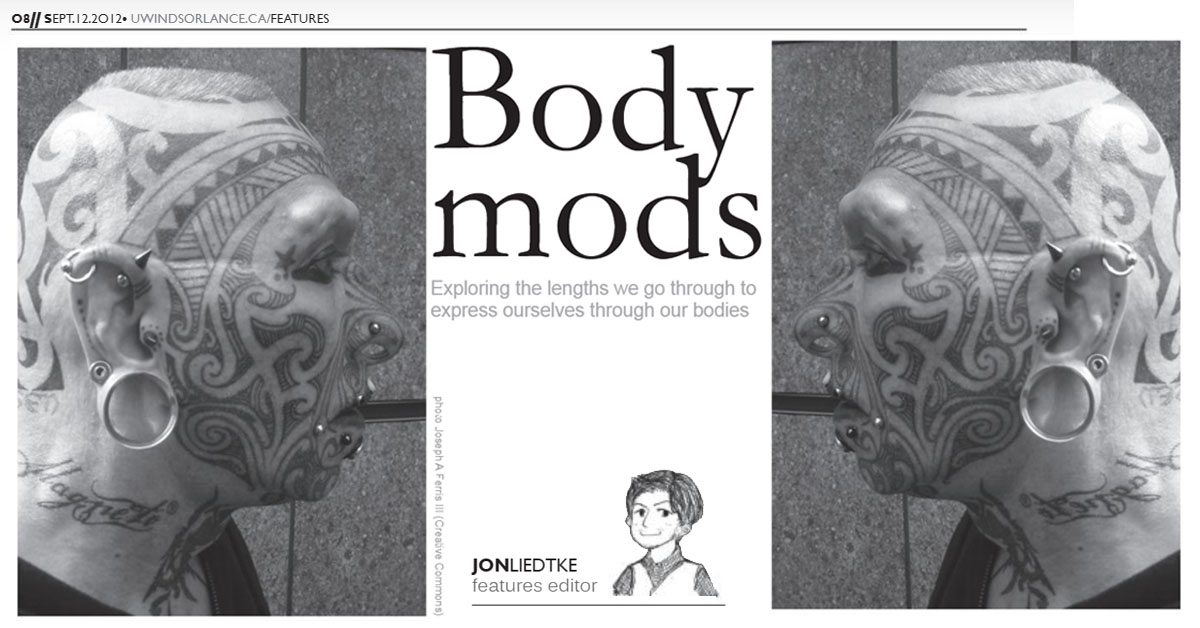UWindsor Lance
Issue 11, Volume 85
Sept. 12, 2012
Jon Liedtke
Exploring the lengths we go through to express ourselves through our bodies
For thousands of years, people from different communities have adorned their bodies with tattoos and piercings. Today, body modification has surged to the forefront of society with people opting to undergo modifications that many question upon seeing.
Body modification typically falls into one of four categories that encompass a whole range of procedures: explicit ornaments, surgical augmentation, removal or split and applying long-term force.
Explicit ornaments include piercings, surgical augmentation includes breast implants, and removal or splitting refers to removing parts of the body or splitting other parts such as the tongue.
According to an article in the British Medical Journal, out of 10,503 respondents over the age of 16, approximately 10 per cent had body piercings located in sites other than the earlobes. The most common piercing sites were the naval at 33 per cent, the nose or ear (other than the lobe) at 19 per cent and 13 per cent, the tongue and nipple both tied at nine per cent, and the eyebrow, lip and genitals at eight per cent, four per cent, and two per cent respectively.
Jillian Bleasby has her ears both pierced and stretched, second holes in her ears, two cartilage piercings, and her belly button, lip, and septum pierced. While she is unsure exactly as to why she has gotten as many tattoos as she has, she has always wanted tattoos.
The purposes for body modification for non-medical reasons can include sexual enhancement, curiosity, aesthetics, rite of passage, religious obligation, to create art, shock, or to enhance self-expression.
“There’s something about the lifestyle associated with them that appeals to me I guess,” explained Bleasby, adding, “My first tattoo was my great pepe’s name on my ribs so he’s always next to my heart.”
For Bleasby, the type of tattoo reflects the “type of person you are, and I want everyone to know the type of person I am.”
Bleasby’s ears were first pierced when she was a child, and as such, “[My mother] kind of made that decision for me. I guess stretching my ears, as well as getting my septum and lip pierced, would be a reflection of who I am because I want to be appealing to a certain type of demographic.”
Laguna Beach, Cali. surgeon Dr. Gregg Homer claims to be able to use laser technology to permanently change brown eyes to blue through a harmless procedure.
The technology has been in development for the past 12 years. The energy from Homer’s laser is absorbed by the brown eye’s pigment, causing the body to shed altered pigment tissue and leaving the remaining blue.
This procedure capitalizes on the fact that all humans are born with blue eyes, but the vast majority develop more pigment in their eyes, which causes them to turn brown. Homer simply removes that brown pigment. The procedure is set to cost roughly $5,000 USD, and is expected to be available within two to three years.
Jason Carruthers, a cosmetic eyelash specialist at Windsor’s Visions of Canada, explained that a large amount of people seek coloured contact lenses to enhance their appearance.
“Let’s separate women and men,” stated Carruthers. “Men like to look good too. We look in the mirror, we comb our hair. But with women, it’s a little bit different. It’s like there’s this cosmetic aspect with women. It’s a little unique, they want to look their best at all times; it’s a very powerful motivator.”
Carruthers explained that often times, when somebody tries on coloured contact lenses for the first time, they’ll instantly turn to their friend, and look for feedback.
“Beauty being in the eye of the beholder, that sort of thing. We want to see how other people will react.”
It’s not so much that one eye colour is better than another eye colour, but rather, “we want to see how other people will react to it.”
Dijon Nuculaj apprenticed as a tattoo artist for two years, and has been professionally tattooing for the past four Having been an artist his entire life, his friends put a tattoo machine “in his hand, and was like tattoo me.”
While some people may be drawn to get tattoos due to ‘peer pressure’ or the idolization of musicians and bands, for Dijon, as a tattoo artist, he considers tattoos to be a form of personal advertisement. “When I get tattooed, it’s a good conversation starter, to get people interested in getting tattooed.”
Kirk Guthrie has a few tattoos, and he explained that his tattoo, which runs along the right side of his torso, is a memorable tattoo that he also shares with his brother. “While it’s not a rite of passage or anything, we felt as though we were honouring the family, and the clan.”
Guthrie’s tattoo reads “Sto pro veritate,” which when translated to English means, “I stand for truth.” For him, it’s “Something we felt we should strive to live up to.”
Nuculaj isn’t sure why other people get tattooed, but if he had to give a reason, he said it’s due to “a self-expressive thing. Most of the [customers] I get have either memorial tattoos or someone trying to express themselves in a physical kind of way …[to] accentuate a body part … [to]make something look pretty.”
Body Mods
Issue 11, Volume 85
Sept. 12, 2012
Jon Liedtke
Page 8
Jon Liedtke was the Features and Opinions Editor, Advertising Manager and Deficit Consultant at the UWindsor Lance.




Leave a Reply